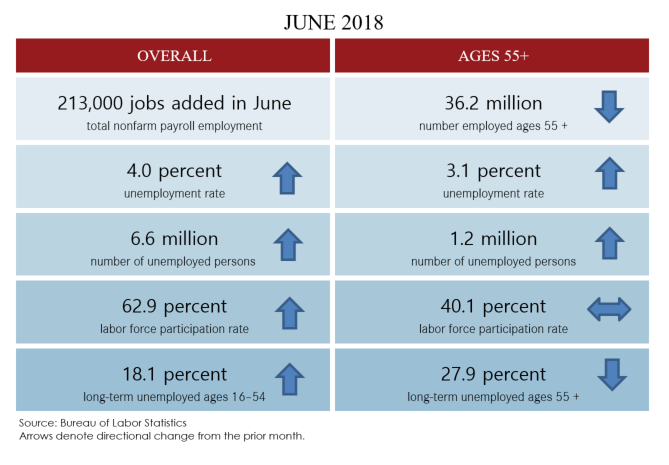AARP Hearing Center
213,000 Jobs Added and Labor Force Continues to Grow in June
By Jennifer Schramm, July 6, 2018 03:18 PM

According to the Bureau of Labor Statistics’ (BLS) June Employment Situation Summary, total nonfarm payroll grew by 213,000 jobs, down from 244,000 jobs (revised up from 223,000) in May. Though the unemployment rate rose from last month’s 18-year low of 3.8 percent to 4.0 percent in June, job growth continued with jobs added in professional and business services, manufacturing, and health care. The labor force participation rate increased to 62.9 percent in June from 62.7 percent in May, while the number of unemployed rose to 6.6 million in June, up from 6.1 million in May.
The number of people ages 55+ who were employed decreased slightly to 36.2 million in June from 36.3 million in May. The number of unemployed people ages 55 and older increased to 1.2 million. The labor force participation rate for those ages 55+ was unchanged at 40.1 percent. The unemployment rate for the 55+ increased from 2.8 percent in May to 3.1 percent in June.
Spotlight: Contingent Workers
Recently released BLS data on contingent workers – those without a contract for ongoing employment, or who are in temporary jobs – show that 3.8 percent of workers, or 5.9 million people, held contingent jobs.
The survey’s three different measures showed contingent work accounted for between 1.3 to 3.8 percent of employment. Estimate 1 (1.3 percent) includes wage and salary workers who expect their jobs will last for an additional year or less and who had worked at their jobs for 1 year or less. Estimate 2 (1.6 percent) includes workers, including the self-employed and independent contractors, who expect their employment to last for an additional year or less and who had worked at their jobs (or been self-employed) for 1 year or less. Temporary help and contract workers are included in this estimate based on the expected duration and tenure with the client to whom they are assigned. Estimate 3 (3.8 percent) includes workers who do not expect their jobs to last. Wage and salary workers are included in this measure even if they already have held the job for more than 1 year and expect to hold the job for at least an additional year. The self-employed and independent contractors are also included if they expect their employment to last for an additional year or less and they had been self-employed or independent contractors for 1 year or less.
The percentages of contingent workers across all three measures were lower in 2017 than in 2005. Many economists had expected to see an increase in the use of contingent workers during this timeframe. Research conducted in 2016 on alternative work arrangements in the United States estimated that the use of contingent workers had increased rapidly between 2005 and 2015.
A few factors may explain the differences between the BLS findings and other research. First, the BLS survey looked at contingent work in the context of primary jobs, and this meant that many people who work temporary or gig jobs in addition to their primary employment were not included in the analysis. In addition, the use of a single week of data provides a snapshot, which may not capture the ebbs and flows of temporary work over time. Finally, data on individuals accessing gig work through mobile apps and websites were not included in the findings. The BLS plans to release this data in September 2018.
When this additional data are available, a more complete picture of the gig economy is likely to emerge. In the meantime, there appears to be widespread agreement that more frequent government data collection on contingent work would improve economists’ and policymakers' understanding of both cyclical and structural changes in the labor force.
For more on the latest employment trends check out the June Employment Data Digest, PPI’s monthly review of jobs data for those ages 55 and over.
Note: Next month’s July 2018 jobs blog and Employment Data Digest will be posted on Monday, August 6, 2018.
































































